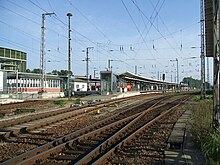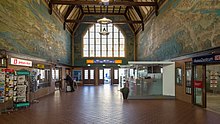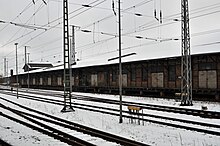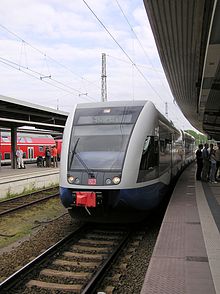Stralsund main station
| Stralsund Hbf | |
|---|---|
|
Reception building (2019)
|
|
| Data | |
| Location in the network | Separation station |
| Platform tracks | 6th |
| abbreviation | WSR |
| IBNR | 8010338 |
| Price range | 3 |
| opening | 1863 |
| Profile on Bahnhof.de | Stralsund_Hbf |
| Architectural data | |
| Architectural style | Neo-Gothic |
| architect |
Alexander Rudell Hans Stubbe |
| location | |
| City / municipality | Stralsund |
| Place / district | Tribseer suburb |
| country | Mecklenburg-Western Pomerania |
| Country | Germany |
| Coordinates | 54 ° 18 '31 " N , 13 ° 4' 38" E |
| Railway lines | |
| Railway stations in Mecklenburg-Western Pomerania | |
The Stralsund Hauptbahnhof is a railway junction in the Hanseatic city of Stralsund in Pomerania . It is located in the center of the intersection between the old town of Stralsund and the Tribseer district or the Tribseer suburb. The station is served by companies belonging to the Deutsche Bahn group and the East German Railway .
Originally just named "Stralsund", the station has been called "Stralsund Hauptbahnhof" since 2010.
In 2016 it was named station of the year .
There is not much left of its former importance in freight transport, and the Stralsund depot, which was once important , has now been closed.
prehistory
The railway connection from Stralsund with the construction of a train station was preceded by decades of efforts and planning by Stralsund merchants and entrepreneurs since 1843. First, in 1863, the Angermünde-Stralsund Railway, a junction from the Berlin-Stettin Railway to Stralsund, built in 1843, was used. The first train arrived in Stralsund on September 27, 1863. After the construction of the first train station, the newly founded Berliner Nord-Eisenbahn-Gesellschaft continued to try to establish a direct connection to Berlin. In 1870 she received the concessions from the states of Prussia and Mecklenburg-Strelitz for this route. On January 1, 1878, operations began on the Berlin Northern Railway with Stralsund as the terminus.
Route connections and track system
About two kilometers southeast of the passenger station, the tracks of the Berlin Northern Railway (single-track), the Angermünde-Stralsund Railway (double-track) and the Stralsund-Sassnitz (double-track) line converge and form a track bundle that runs straight to the station that was originally designed as a terminal station .
In the station, this is distributed on the one hand to tracks 1 to 4, which each share a central platform in pairs (1 + 2 and 3 + 4), both of which in turn end on a transverse house platform . Tracks 1 to 3 end at the cross platform as butt tracks , while outer track 4 runs as a through track parallel to and together with tracks 5 and 6, which are also brought in from the southeast, past the side wing of the station to the west; from there, tracks 4, 5 and 6 will be merged to form the Stralsund – Rostock railway line . The two tracks 5 and 6 have a common island or central platform at the same height as the other two platforms , this is connected at the northern end with an underpass under the tracks 4 and 5 with the transversely arranged house platform.
Investments
First station building
Due to the fortress character of Stralsund, at the instigation of the Prussian War Ministry, initially only a wooden reception building was built in 1863 . This should be able to be destroyed quickly in the event of an attack on the city. It measured around 30 × 10 meters in square and had two waiting rooms.
Today's reception building
After the city was de-fortified, a new entrance building made of exposed brickwork was built according to a design by the Royal Railway Directorate in Stettin . The detailed construction design and the later construction management was carried out under the official leadership of the Real and Secret Senior Building Councilor Alexander Rüdell (Berlin) by the agricultural inspector (and later professor at the Technical University of Braunschweig) Hans Stubbe. Construction began on November 9, 1903 and opened to traffic on March 29, 1905.
The station reception building on the site of the former cattle ramp on Tribseer Damm was set back from the street, creating a space that was used by cabs and later by trams and trains of the Stralsund-Barth-Damgarten small railway . Today there are short-term parking spaces and a taxi rank here.
The building complex is just over 50 meters wide along the street front and around 40 meters deep, including the protruding western wing. The central entrance hall is almost 9.90 meters wide, 22.12 meters deep and 15 meters high in the direction of the tracks. There are large windows above the entrance and the access to the platforms.
Service rooms were originally located in the western area of the hall. In the eastern area there were three waiting rooms: one exclusively for women, one for passengers in 1st and 2nd carriage classes and one for travelers in 3rd and 4th carriage classes. A tower next to the entrance hall, which houses a staircase, should be based on the architecture of the three large Stralsund parish churches. The large clock face of the tower clock, which was directed exactly towards the town hall, could be illuminated with a lantern above it. The lantern housing is still intact (as of 2013).
On the evening of March 28, 1905, the new station was inaugurated with a party. This lasted until the following morning hours, when the official commissioning took place with the departure of train No. 206 to Neubrandenburg. The “Stralsunder Tageblatt” wrote: “Today, rail traffic in Stralsund has entered a new stage, in which the long-standing wish of our residents for a new train station has finally come true. The hustle and bustle at the new station made a really big-city impression when it opened today. "
In the 1930s, the Stralsund artist Erich Kliefert was commissioned to redesign the reception hall. For the western side in the upper area of the hall he chose a large-format color representation of Stralsund from a bird's eye view and for the eastern side a similar representation of the island of Rügen . Both paintings were created in 1935.
In the 1990s, the building was renovated and the area in front of the platforms was covered with a generous glass roof. The sanitary areas were renewed and shops were located in the reception hall.
Platform systems
The platforms in the first version were not covered. Access to the platforms was also possible by directly crossing the tracks on foot.
After the completion of the reception building in 1905, access to platform tracks 1 to 4 was simplified with an adjoining cross platform. Travelers who wanted to use the through track built in 1888 to and from Berlin or Stettin to and from Rostock , however, still had to cross the tracks directly in front of the island platform to the west. Only later was the current tunnel to the island platform built.
The two head platforms are each about 340 meters long, the island platform for the continuous Berlin / Stettin – Rostock line is 400 meters long (as of 2013).
Freight transport
Parallel to the tracks of the island platform on the route to Rostock there are four other tracks, on the outermost of which there are buildings for a local freight facility .
Train provision system
By the end of 2020, Deutsche Bahn will build a provisioning system for its long-distance trains on the site of the former depot. Seven tracks with a length of 360 to 430 meters each will be built on an area of 48,000 m². 22 million euros are being invested in this. The ending and starting trains are cleaned here and supplied or disposed of with fresh and service water, and minor repairs are carried out.
Stralsund depot
When the station was opened in 1863 by the Berlin-Szczecin Railway Company, there was also a simple locomotive shed. The rectangular building offered space for two machines. With the opening of the Demmin – Stralsund section by the Berliner Nord-Eisenbahn-Gesellschaft in 1878, a four-hour roundhouse and a repair shop were built on what would later become the Stralsund depot . The engine shed had to be expanded after a short time so that in 1883 it comprised 14 stalls.
After the nationalization of the two companies, the facilities were taken over by the Prussian State Railways and combined into a depot. Initially, the Berlin directorate was responsible for the facilities, and in 1895 the depot was transferred to the Szczecin directorate . By 1889 the roundhouse had grown to 19 stalls. A second roundhouse with a 16 m turntable was partially put into operation in 1895, and in 1905 the building comprised 19 stalls. A new workshop - later used as administration and warehouse - was built between engine sheds I and II. Although further expansion plans were available, construction work on Roundhouse III could not begin until 1917 due to the First World War . The 21-permanent building was completed in 1921. It was primarily designed for the express train locomotives stationed in Stralsund. Therefore, in 1940 the 20 m turntable was replaced by a model with a 23 m stage length.
At the end of the 1950s and 1960s the depot was modernized. Among other things, this resulted in a high-rise coal bunker and a gas station with oil storage. In 1980 the bunker was demolished again.
In May 1985, the depot was built in honor of the Nazi victim Otto Scharfschwerdt in Bahnbetriebswerk "Otto Scharfschwerdt" Stralsund renamed. From 1990, the significance of the depot started by the economic changes after the turn to fall in 1989/90. With the merger between the Deutsche Reichsbahn and the Deutsche Bundesbahn , the Stralsund depot was converted into the Stralsund depot . Since 1999 there has only been one branch of DB in Stralsund, which was completely dissolved on July 1, 2001 and from then on only served as a personnel deployment point. Shortly beforehand, the workshop was closed in June 2011.
The locomotive sheds on the service tracks to the south-east and below the approach of the E 22 to the new Rügen Bridge are no longer in use and are falling into disrepair (status: 2011).
- Departments
After the Second World War, Stralsund only had one locomotive deployment site in Greifswald and one in Wolgast harbor. It was not until the end of the 1960s that numerous small railway depots were closed down that numerous deployment sites were added. The Putbus depot - which in turn brought the Altenkirchen, Bergen (Rügen) Ost, Garz and Göhren branch offices with it - was incorporated into the Stralsund depot on January 1, 1967. On January 1, 1968, the previously independent Barth and Saßnitz depots were subordinated to the Stralsund depot. The Franzburg and Tribsees locomotive stations were thus also part of the depot. While the locomotive stations Garz (1967), Altenkirchen (1968), Franzburg (1969) and Bergen (Rügen) Ost (1971) were closed quite soon, the remaining stations remained until after 1990.
The Seebad Heringsdorf depot was incorporated into Stralsund on September 1, 1992. In addition, from 1994 the locomotives of the Mukran ferry port were located in Stralsund.
- Locomotive use
After the end of the war, in the 1940s and 1950s, the 38.10-40 and 41 series were mainly used in passenger transport and the 52 series in freight train service. The locomotives of the 03.10 series that remained with the Deutsche Reichsbahn in the GDR were brought together in Stralsund from 1954. For the next 25 years or so, they were used by express trains from Stralsund. From then on, the class 41 was increasingly used for freight train service. The new class 50.40 steam locomotives were also used in front of freight trains from Stralsund in the 1960s.
The traction change began in 1967 with the stationing of the DR series V 200 in Stralsund, from 1969 vehicles of the DR series V 100 also came to Stralsund. By 1973 they had displaced all steam locomotives except for the 03.10 series. The last steam locomotives could only be gradually replaced by the DR class 142 and the weaker motorized locomotives of the DR class 132 towards the end of the 1970s . In May 1980, a steam locomotive - 03 1010 - was used by the Stralsund depot for the last time.
With the advancing electrification, electric locomotives were first located in Stralsund from 1988 with the DR class 243 . In 1996 all the electric locomotives that were still in existence were given to other offices.
Current train connections
Long-distance transport
Status: December 2017
| line | Course of the journey | Tact | EVU | Vehicle material | ||
|---|---|---|---|---|---|---|
| ICE 15 | Bergen on Rügen - Stralsund - Prenzlau - Berlin - Halle (Saale) - Erfurt - Frankfurt (Main) | a pair of trains (Sa) | DB Fernverkehr AG | ICE T | ||
| ICE 28 | ( Binz -) Stralsund - Prenzlau - Berlin - Leipzig - Erfurt - Bamberg - Nuremberg - Munich | a pair of trains daily | ||||
| ICE 29 | ( Binz -) Stralsund - Prenzlau - Berlin - Halle (Saale) - Erfurt - Bamberg - Erlangen - Nuremberg - Munich | a pair of trains (Sun) | ||||
| ICE 26 | ( Binz -) Stralsund - Rostock - Hamburg - Hanover - Göttingen - Frankfurt (Main) - Karlsruhe | Every two hours, sometimes only to Hanover, Göttingen or Frankfurt (Main) | ||||
| IC 28 | Stralsund - Greifswald - Züssow - Anklam - Prenzlau - Eberswalde - Bernau (b Berlin) - Berlin Hbf - Berlin Südkreuz | two pairs of trains (Mon – Thu + Sat); a pair of trains (Fri + Sun) | BR 101 / BR 120 + InterCity car | |||
| IC 30 | ( Binz - or Züssow - Greifswald -) Stralsund - Rostock - Schwerin - Hamburg - Bremen - Dortmund - Cologne - Mainz - Stuttgart | two pairs of trains a day | ||||
| Stralsund - Rostock - Schwerin - Hamburg-Harburg - Münster (Westf) - Recklinghausen (Sun) - Gelsenkirchen - Essen - Duisburg - ( Düsseldorf (Sa) -) Cologne | a pair of trains (Sat + Sun) (from 7 July 2018) | |||||
| IC 32 | Binz - Stralsund - Anklam - Prenzlau - Eberswalde - Berlin-Spandau - Wolfsburg - Hanover - Bielefeld - Hamm (Westphalia) - Dortmund - Bochum - Essen - Duisburg - Düsseldorf - Cologne | a pair of trains (Fri-Sun) | ||||
| IC 56 | Stralsund - Prenzlau - Berlin-Spandau - Stendal - Hanover - Nienburg (Weser) - Bremen - Delmenhorst - Oldenburg (Oldbg) | a pair of trains (Sun) | ||||
Some of the long-distance trains only run to Binz in the summer (holiday season) and end in Stralsund in the other months.
Local transport
Status: December 2019
| line | Course of the journey | Cycle (min) | EVU | Vehicle material |
|---|---|---|---|---|
| RE 3 | Stralsund - Züssow - Prenzlau - Angermünde - Eberswalde - Berlin - Jüterbog - Falkenberg (Elster) | 120 | DB Regio Nordost | Locomotive + double deck car |
| RE 5 | Stralsund - Neubrandenburg - Neustrelitz - Berlin - Wünsdorf-Waldstadt | 120 | ||
| Stralsund - Neubrandenburg - Neustrelitz | 120 | Bombardier Talent 2 (BR 442) | ||
| RE 9 | Stralsund - Mountains on Rügen - Lietzow - Binz | 120 | East German Railway | Siemens Desiro Mainline |
| Rostock - Ribnitz-Damgarten - Velgast - Stralsund - Mountains on Rügen - Lietzow - Sassnitz | 120 | |||
| RE 10 | Stralsund - Greifswald - Züssow | 120 | ||
| Rostock - Ribnitz-Damgarten - Velgast - Stralsund | Single trips |
literature
- Andreas Neumerkel: Stralsund main station is 100 years old. In: Ostsee-Zeitung from January 19, 2005
- Herbert Ewe : History of the city of Stralsund . Hermann Böhlaus successor, Weimar 1984
- Birkholz: The train station in Stralsund. In: Zentralblatt der Bauverwaltung, vol. 41 (1921) No. 51, pp. 313-315
- Heiko Bergmann: Stralsund depot. Bufe-Fachbuch-Verlag, Egglham 1999, ISBN 3-922138-68-3
Web links
- Tracks in service facilities (WS) , DB Netz AG (PDF)
Individual evidence
- ^ Station of the year: Stralsund and Steinheim win. August 22, 2016. Retrieved August 22, 2016 .
- ↑ a b Hauptbahnhof. hansestadt-stralsund.de, accessed on November 3, 2014 .
- ↑ Stralsunder Tageblatt of March 29, 1905.
- ^ "Pit stop" for trains in Stralsund on ndr.de, accessed on June 5, 2020.
- ↑ Mecklenburg-Western Pomerania: Deutsche Bahn is investing 22 million euros in a new ICE pit stop for Stralsund. In: LOK Report. June 4, 2020, accessed June 4, 2020 .
- ↑ Klaus-Jürgen Kühne: Railway depot of the GDR - 1949-1993 , transpress-Verlag, Stuttgart 2011, ISBN 978-3-613-71401-4 , p. 82
- ↑ Klaus-Jürgen Kühne: Railway depot of the GDR - 1949-1993 , transpress-Verlag, Stuttgart 2011, ISBN 978-3-613-71401-4 , p. 82 f.
- ↑ a b c d e Klaus-Jürgen Kühne: Bahnbetriebswerke der DDR - 1949–1993 , transpress-Verlag, Stuttgart 2011, ISBN 978-3-613-71401-4 , p. 83
- ↑ http://www.gdl-stralsund.de The railway network around Stralsund and the Stralsund railway depot ( Memento of the original from May 23, 2006 in the Internet Archive ) Info: The archive link was inserted automatically and has not yet been checked. Please check the original and archive link according to the instructions and then remove this notice. (accessed on January 21, 2013)
- ↑ a b Klaus-Jürgen Kühne: Bahnbetriebswerke der GDR - 1949–1993 , transpress-Verlag, Stuttgart 2011, ISBN 978-3-613-71401-4 , p. 84
- ^ DB Kursbuch, accessed on January 6, 2013






